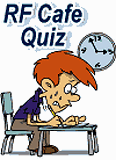 All RF Cafe Quizzes make great fodder for
employment interviews for technicians or engineers - particularly those who are
fresh out of school or are relatively new to the work world. Come to think of it,
they would make equally excellent study material for the same persons who are going
to be interviewed for a job. Bonne chance, Viel Glück, がんばろう,
buena suerte, удачи, in bocca al lupo, 행운을 빕니다,
ádh mór, בהצלחה, lykke til, 祝你好運.
Well, you know what I mean: Good luck! All RF Cafe Quizzes make great fodder for
employment interviews for technicians or engineers - particularly those who are
fresh out of school or are relatively new to the work world. Come to think of it,
they would make equally excellent study material for the same persons who are going
to be interviewed for a job. Bonne chance, Viel Glück, がんばろう,
buena suerte, удачи, in bocca al lupo, 행운을 빕니다,
ádh mór, בהצלחה, lykke til, 祝你好運.
Well, you know what I mean: Good luck!
Click here for the complete list of
RF Cafe Quizzes.
Note: Some material based on books have quoted passages.
 This quiz is based on the information presented
in Battlespace Technologies: Network-Enabled Information Dominance, by Richard S.
Deakin. Published by Artech House. This quiz is based on the information presented
in Battlespace Technologies: Network-Enabled Information Dominance, by Richard S.
Deakin. Published by Artech House.
Note: Some of these books are available
as prizes in the monthly RF Cafe Giveaway.
This book has some of the best photos of modern war-fighting technology that
I have seen.
"The era of mechanized warfare is rapidly giving way to the battle for
information superiority enabled by electronic technologies that provide data for
detailed analysis of enemy forces and capabilities. Supported with over 400
color photographs and illustrations, this new book is written and designed
specifically to help non-specialists quickly understand the complexities of
Network Enabled Capability (NEC). It offers professionals expert guidance on how
to achieve information dominance throughout the battlespace by effectively
employing the technologies, concepts, and decision-making processes of network
enabled warfare. Written in clear, non-technical language with minimum
mathematics, this book discusses how to use sensor technologies, including radar
and electronic warfare systems, to disseminate information to key decision
makers in timely and relevant manner..."
1. What is the most significant difference between past
generations in war-fighting technology and contemporary technology?
a) Nuclear weapons
b) Women in the military
c) Pilotless vehicles
d) Information dominance
2. This new Network Enabled Capability (NEC), depends
on which of these philosophies?
a) Think globally, not locally
b) Think synchronized knowledge, not synchronized requests
c) Think loosely coupled flexibility, not tightly coupled efficiency
d) All the above
3. Match the following network names to the diagrams.

| A ________ |
Delany triangulation |
| B ________ |
Circular |
| C ________ |
Fully connected |
| D ________ |
Centralized |
| E ________ |
Hierarchical |
| F ________ |
Minimally connected |
| G ________ |
Multi-input multi-output node |
| H ________ |
Random |
(see page 65)
4. Which system provides technically derived intelligence
to detect, locate, track, identify,
and describe the specific characteristics of fixed and
dynamic target objects and sources?
a) MASINT (measurement and signature intelligence)
b) HUMINT (human intelligence)
c) ELINT (electronic intelligence)
d) RADINT (radar intelligence)
5. Which phenomenon is NOT a component of an aircraft's
detection signature?
a) Wake turbulence and aerodynamic surface heating
b) Optical glint and acoustic signature
c) Pilot size and weight
d) Radar emissions and IR exhaust signature
6. What is "layered surveillance?"
a) Stacking of threats in order of relevance
b) Using multiple generations of technologies
c) Stacking physical layers of IP data
d) Deploying sensors at various altitudes from ground to space
7. Which markup language / protocol is fictitious?
a) Microsoft Markup Language (MML)
b) eXtensible Markup Language (XML)
c) Transducer Markup Language (TML)
d) Hyper Text Markup Language (HTML)
8. Long-range communications is most dependent on which
parameter
a) More on frequency than on power
b) More on power than on frequency
c) Equally on both
d) Neither
9. What is a primary characteristic of burst communications?
a) Amplitude Modulation
b) Data compression
c) Quadrature modulation
d) Bursts

10. What
is shown in the picture to the right?
a) An autonomous robotic spider
b) A articulately tactile sensor unit
c) An inverted "dead bug" IC mounting configuration
d) A Klingon spaceship
Need some help? Click here
for the answers and explanations.
Posted 5/12/2022
|






























